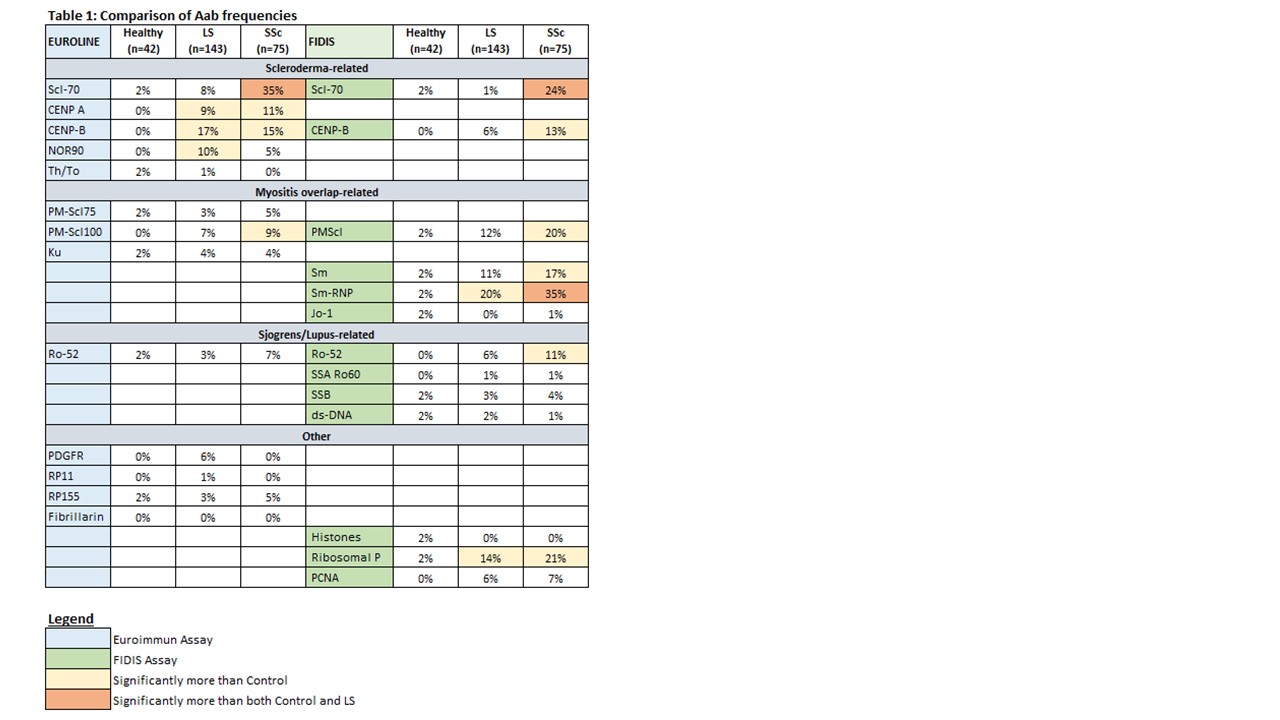Session Information
Session Type: Abstract Session
Session Time: 3:15PM-3:30PM
Background/Purpose: Pediatric scleroderma encompasses juvenile onset localized scleroderma (jLS) and juvenile onset systemic sclerosis (jSSc), both of which present with varied cutaneous fibrosis and systemic involvement. Autoantibodies (Aab) help serve as a prognostic tool for adult onset SSc disease manifestations; however, their clinical relevance for jSSc and jLS remains unclear. Development of commercially available Aab panels facilitates testing but requires clinical validation in pediatric cohorts. Using two of these panels, we sought to compare Aab profiles between jLS and jSSc, and investigate the association of Aabs in jLS with clinical characteristics.
Methods: Sera from 42 age-matched pediatric healthy controls (HC), 75 jSSc patients, and 143 jLS patients (IRB #STUDY19080297) underwent Aab phenotyping with the FIDIS™(F) Connective Profile addressable laser bead immunoassay (ALBIA) (TheraDiag, Paris, France) and the EUROLINE™(E) SSc Profile line immunoassay (LIA) (Euroimmun, Germany) comprising 26 distinct Aabs. Cutoffs were defined from HC and applied to jLS and jSSc samples to determine Aab positivity. Chi-square analysis was used to compare Aab profiles between cohorts and determine significant (p< 0.05) relationships with clinical variables. For Aabs significantly higher in frequency than HC, poly-positivity profiles (3 or more Aab) were analyzed.
Results: Overall, Aab were positive in 80% of jSSc patients and 41% of jLS patients. Significant Aab elevation compared to HC, unique to jSSc, included Scl-70 (both), PM-Scl100 (E), PM-Scl (F), Sm (F), and Ro-52 (F) (Table 1). Whereas NOR90 (E) was unique to jLS compared to HC. Shared Aabs between jLS and jSSc, significantly elevated compared to HC, included CENP-A (E), CENP-B (E), Sm-RNP (F) and ribosomal P (Rib P) (F). Among jSSc, the most common Aabs were Scl70 (36%), Sm-RNP (35%), and Rib P (25%). Scl70 was the most common among single positive patients (41%), while combination of Sm-RNP, Sm, and Rib P were present among all polypositive jSSc patients. Most frequent Aabs in jLS were Sm-RNP (20%), CENP-B (17%), and Rib P (15%), with the combination of Sm-RNP/Rib P (53%) in polypositive patients. In jLS, those with 3+ Aabs had significantly elevated skin and global disease activity scores (Table 2). Rib P Aab positivity associated with jLS face/scalp involvement (OR 3.056, 95% CI: 1.16-10.55, p=0.026).
Conclusion: Using two scleroderma-targeted Aab panels, we observed that jLS patients have a lower frequency of Aab positivity compared to jSSc. This jSSc cohort had predominant Scl-70 positivity, as adult SSc, but differs in higher frequency of overlap Aab including PM-Scl and Sm-RNP. jLS patients share a number of Aabs with jSSc, namely Sm-RNP, Rib P, and anti-centromere (CENP-A, CENP-B) suggesting a degree of pathophysiologic overlap. Unique Aab patterns emerged based on the quantity of positive Aabs present and were associated with skin and global disease activity parameters. Rib P Aabs were associated with head involvement among jLS patients. Overall, our findings suggest that the jLS Aab profile is similar, but distinct from, jSSc and may be related to clinical disease characteristics.
To cite this abstract in AMA style:
Li J, Mirizio E, Buhler K, Choi M, Hou H, Werner G, Sanyal A, Schollaert-Fitch K, Fritzler M, Torok K. Autoantibody Testing in Juvenile Localized Scleroderma and Systemic Sclerosis: Comparing Antibody Profiles and Clinical Correlations [abstract]. Arthritis Rheumatol. 2021; 73 (suppl 9). https://acrabstracts.org/abstract/autoantibody-testing-in-juvenile-localized-scleroderma-and-systemic-sclerosis-comparing-antibody-profiles-and-clinical-correlations/. Accessed .« Back to ACR Convergence 2021
ACR Meeting Abstracts - https://acrabstracts.org/abstract/autoantibody-testing-in-juvenile-localized-scleroderma-and-systemic-sclerosis-comparing-antibody-profiles-and-clinical-correlations/


